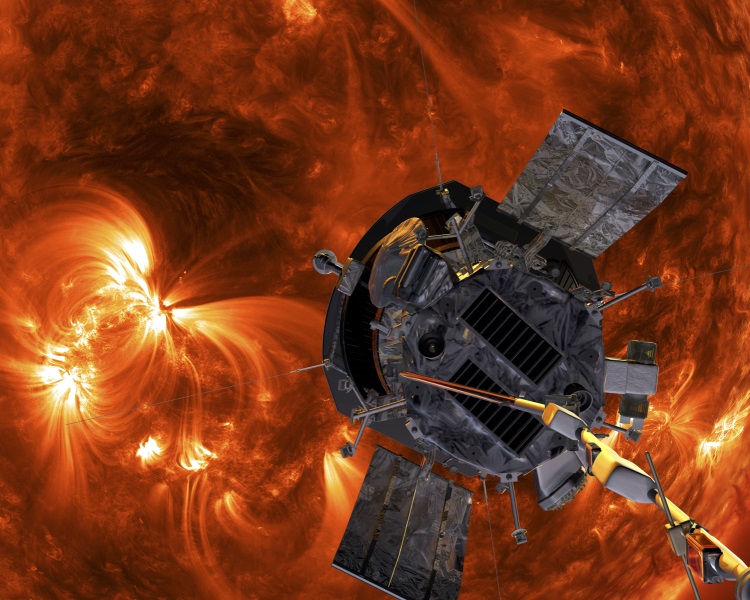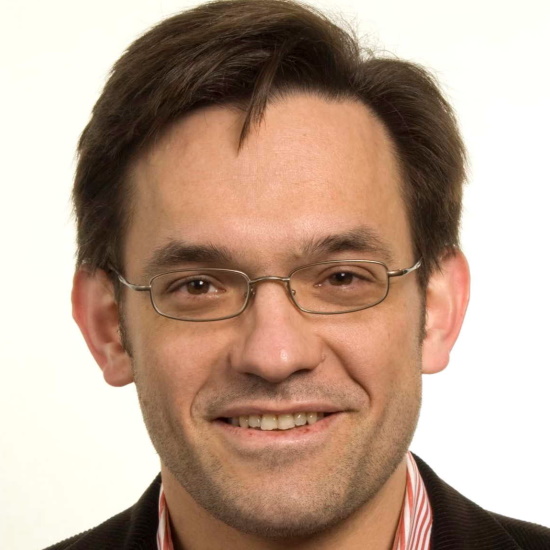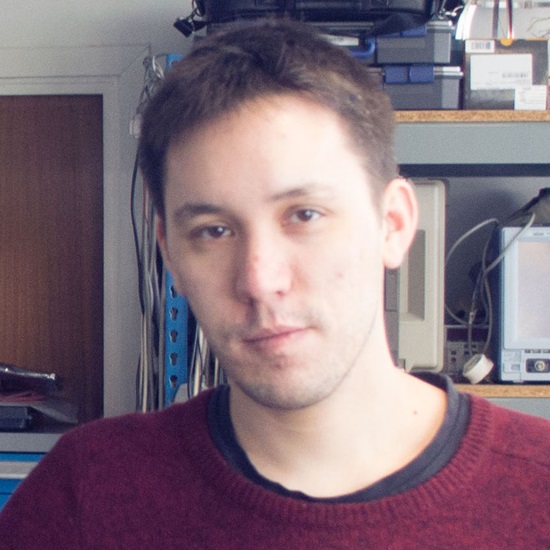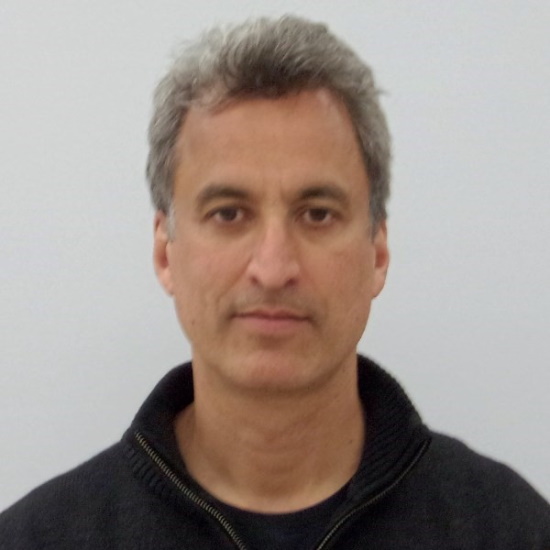Links to external sources may no longer work as intended. The content may not represent the latest thinking in this area or the Society’s current position on the topic.
Turbulent dissipation in space plasmas

Theo Murphy meeting organised by Dr Julia Stawarz, Dr Daniel Verscharen and Dr Christopher Chen.
This meeting brought together experts on plasma turbulence in the solar wind and Earth's magnetosphere to discuss the latest cutting-edge results on the role of collision-less plasma processes in turbulent energy dissipation from the revolutionary Magnetospheric Multiscale and Parker Solar Probe spacecraft. These discussions provided crucial input for the ongoing science operations of these and future space missions.
The schedule of talks and speaker biographies are available below. Speaker abstracts are also available below.
Attending this event
This meeting has taken place.
Enquiries: contact the Scientific Programmes team.
Organisers
Schedule
Chair

Dr Daniel Verscharen, Mullard Space Science Laboratory, University College London, UK

Dr Daniel Verscharen, Mullard Space Science Laboratory, University College London, UK
Daniel received his PhD from the Max Planck Institute for Solar System Research and the Technical University Braunschweig, Germany in 2012 for his work on convected wave structures and spectral transfer in space plasmas. He then moved to the University of New Hampshire’s Space Science Center, where he worked on the kinetic physics of the solar wind as a Research Scientist and later as a Research Assistant Professor. Since 2017, he holds an Ernest Rutherford Fellowship from the UK’s Science and Technology Facilities Council (STFC) and a position as a Proleptic Lecturer in Space Plasma Physics at the University College London’s Mullard Space Science Laboratory (MSSL). He is a leading expert in combining theoretical studies with spacecraft observations to understand the kinetic physics of the solar wind and turbulence in space plasmas.
| 08:00 - 08:05 | Welcome by the Royal Society and the lead organiser |
|---|---|
| 08:05 - 08:35 |
The discrete sources of solar wind energisation
After eleven orbits around the Sun, measurements from the NASA Parker Solar Probe mission have begun to reveal the nature of solar wind energisation and its discrete sources. Previously termed 'microstreams', individual streams of hot, accelerated solar wind are emerging from coronal holes and are organised in Carrington longitude by the known angular scale of the photospheric network magnetic field. These discrete microstreams are highly Alfvenic, show faster, hotter solar wind, enhanced alpha particle abundance, and steep suprathermal ion tails to greater than 100 keV. The microstream structures overexpand and merge together to form a more homogeneous solar wind in the outer heliosphere. The origin of this solar wind in the network magnetic 'funnels' at the boundary of supergranulation cells provides clues as to the physical mechanisms at work to impart energy. Professor Bale will review the state of the art of the PSP measurements and their implications for the coronal heating problem. 
Professor Stuart D Bale, University of California Berkeley, USA

Professor Stuart D Bale, University of California Berkeley, USAStuart D Bale is a Professor of Physics at the University of California, Berkeley. He is the former Director of the Berkeley Space Sciences Laboratory (SSL) there. He received his PhD in Physics from the University of Minnesota in 1994. After three years of postdoctoral work at Queen Mary College, University of London, he joined UC Berkeley. He has held visiting positions at the Observatoire de Paris, Meudon (Univ. Paris VII), the University of Sydney and Imperial College, London. He is the recipient of the 2003 US Presidential Early Career Award for Scientists and Engineers (PECASE) and a Fellow of the American Physical Society (APS). Bale is interested in experimental plasma astrophysics and particle energization in astrophysical and heliospheric plasmas. He is the NASA Principal Investigator for experiments on the Wind, STEREO, and Parker |
| 08:35 - 08:50 | Discussion |
| 08:50 - 09:20 |
MMS in the turbulent transition region of Earth’s bow shock and beyond
In this talk, Dr Gingell will begin with a discussion and review of the measurements and observations of turbulence accessible in the near-Earth plasma environment by the Magnetospheric Multiscale (MMS) mission. She will then present recent advances in using MMS observations to characterise turbulent processes in the Earth’s bow shock and near-shock magnetosheath. Simulations and observations have revealed that the bow shock hosts an apparently turbulent or disordered transition region generated by instabilities in the shock foot. This region is known to contain coherent, reconnecting current structures, similar to those found in other turbulent plasmas such as the solar wind and magnetosheath. Many of these structures are convected through the shock layer, surviving into the magnetosheath downstream. We expect these thin current sheets and flux ropes to play a significant role in dissipation of turbulent fluctuations through the shock transition. However, it is not yet clear whether these shock processes are separable from processes in the sheath: are they localised to a thin shock layer, or does shock-driven turbulence smoothly evolve into magnetosheath turbulence? In order to investigate these questions, Dr Gingell will present recent studies for which she quantifies the prevalence of thin current sheets and characterise the turbulent magnetic fluctuations as they evolve through the shock transition region. 
Dr Imogen Gingell, University of Southampton, UK

Dr Imogen Gingell, University of Southampton, UKDr Imogen Gingell is a Royal Society University Research Fellow based in the space environment physics group at University of Southampton. She gained her PhD in fusion plasma physics at the University of Warwick in 2013, and went on to join space physics groups at Queen Mary University of London and Imperial College London. Her research targets kinetic-scale plasma process including instabilities, magnetic reconnection and turbulence, with a particular focus on the dynamics and energetics of collisionless shock waves. She has experience with both observation data (especially with Magnetospheric Multiscale) and numerical simulations, with several studies using combinations of the two to characterise complex regions of Earth’s local plasma environment. |
| 09:20 - 09:35 | Discussion |
| 09:35 - 10:00 | Coffee |
| 10:00 - 10:30 |
Alfvénic and non-Alfvénic turbulence in the inner heliosphere: insights from Parker Solar Probe
Professor Velli will discuss the turbulence embedded in the solar wind outflow observed by Parker Solar Probe over the first 10 encounters, including characteristics such as overall magnitude, Alfvénicity, relative magnitude of density fluctuations, prevalence of switchback structures. He will then describe what we have learned thanks to Parker of the relationship of the turbulence properties to the solar wind origins, before arguing how structures such as magnetic funnels, isolated coronal holes, coronal hole boundaries, pseudostreamers, helmet streamers and the nascent heliospheric current sheet contribute to the formation and evolution of turbulence in the inner heliosphere. 
Professor Marco Velli, UCLA, USA

Professor Marco Velli, UCLA, USAA student of the University of Pisa and Scuola Normale Superiore, he has spent research periods at the University of St. Andrews, Paris Observatory, as well as the Jet Propulsion Laboratory, where he remains a Senior Scientist. Marco Velli’s research has focused on space plasma physics and solar magnetic activity. Velli was the first to suggest that wave reflection plays a role in the formation of the turbulence spectrum seen in the solar wind. This work was the basis for his election to AGU fellowship in 2014. Professor Velli demonstrated the dynamical reason the solar wind is supersonic and showed that generally speaking subsonic flows connecting a star to the interstellar medium survive only over a vanishingly small range of parameters. Professor Velli played a major role in the development of Parker Solar Probe (PSP), as well as in the Science Definition team for Solar Orbiter. |
| 10:30 - 10:45 | Discussion |
| 10:45 - 11:15 |
An incomplete theory of dissipation in collisionless plasmas
Fluid-based studies of dissipation have met with great success in collisional mediums including work in turbulence and dense plasmas. However, this success has not been fully realized in collisionless plasmas where a better understanding of dissipation has been elusive. The essence of the problem that, in a collisionless plasma, there may be no 'good' definition of fluid parameters that separates internal energy from flow energy. To avoid this issue, Professor Ergun takes an approach to dissipation that involves phase-space mixing or 'scattering domains'. He shows that, when phase-space mixing or 'scattering domains' are considered, Liouville's theorem does not necessarily apply and that Vlasov’s equation does not necessarily conserve entropy. He develops an incomplete theory based on Lyapunov-like scattering that may be able to predict dissipation rates based on electric field spectra in a simple 1D system. 
Professor Robert Ergun, University of Colorado Boulder, USA

Professor Robert Ergun, University of Colorado Boulder, USAProfessor Robert Ergun is in the Department of Astrophysical and Planetary Sciences and a member of the Laboratory for Atmospheric and Space Physics at the University of Colorado at Boulder, CO. He has provided flight hardware for measuring electric fields and particles in space on eight NASA satellite missions including Wind, FAST, STEREO, THEMIS, RBSP, MAVEN, MMS, and Parker Solar Probe. |
| 11:15 - 11:30 | Discussion |
Chair

Professor Stuart D Bale, University of California Berkeley, USA

Professor Stuart D Bale, University of California Berkeley, USA
Stuart D Bale is a Professor of Physics at the University of California, Berkeley. He is the former Director of the Berkeley Space Sciences Laboratory (SSL) there. He received his PhD in Physics from the University of Minnesota in 1994. After three years of postdoctoral work at Queen Mary College, University of London, he joined UC Berkeley. He has held visiting positions at the Observatoire de Paris, Meudon (Univ. Paris VII), the University of Sydney and Imperial College, London. He is the recipient of the 2003 US Presidential Early Career Award for Scientists and Engineers (PECASE) and a Fellow of the American Physical Society (APS). Bale is interested in experimental plasma astrophysics and particle energization in astrophysical and heliospheric plasmas. He is the NASA Principal Investigator for experiments on the Wind, STEREO, and Parker
Solar Probe missions and the NASA Lunar Surface Electromagnetics (LuSEE) experiment to fly on a lunar lander in 2024.
| 12:30 - 13:00 |
Kinetic physics of dissipation
In this talk, Dr Klein will discuss recent advances in our theories for the dissipation of turbulence in weakly collisional plasmas and the role that such dissipation plays in governing the evolution of space and astrophysical systems. An overview of the various mechanisms that couple the turbulent electromagnetic fields to the particle flows and distributions is provided, as well as evidence for these different processes from numerical simulations as well as in situ measurements of the plasma from NASA and ESA missions such as Parker Solar Probe, Solar Orbiter, and MMS. Open questions regarding what work needs to be done to ascertain what dissipation mechanisms act under what conditions will be posed, as well as possible advances that will be enabled by future observations, such as multi-point, multi-scale measurements from missions such as HelioSwarm. 
Professor Kristopher G Klein, The University of Arizona, USA

Professor Kristopher G Klein, The University of Arizona, USAKristopher Klein is an Assistant Professor at the University of Arizona at the Lunar and Planetary Laboratory. Professor Klein studies turbulent transport and dissipation in space and astrophysical plasmas, describing how energy moves through and is removed from such systems. He received a BA in Physics and Mathematics from Luther College in 2008 and his PhD in 2013 from the University of Iowa, modelling solar wind turbulence using numerical simulations. He worked as a postdoc at the University of New Hampshire and the University of Michigan studying preparing predictions for NASA’s Parker Solar Probe mission as a member of the SWEAP Science team. He started his current position at University of Arizona in 2018, and is the Deputy Principle Investigator of the HelioSwarm Mission, a NASA MidEx composed of nine spacecraft set to be launched in the late 2020's to study the cross-scale nature of turbulence in near-Earth plasmas. |
|---|---|
| 13:00 - 13:15 | Discussion |
| 13:15 - 13:45 |
How non-equilibrium thermodynamics constrains magnetohydrodynamics, in the solar wind and beyond
In this talk, Professor Kunz will focus on the different ways in which departures from local thermodynamic equilibrium, produced naturally in weakly collisional plasmas and biased anisotropically by magnetic fields, place constraints on plasma dynamics in the solar wind and other astrophysical environments. These constraints afflict not only simple waves and fundamental plasma processes such as magnetic reconnection, but also highly nonlinear phenomenon like plasma turbulence and particle energization. After providing some background and observational context, three demonstrations of this physics will be featured. (1) Above a beta-dependent amplitude threshold, Alfvén waves interrupt their own propagation, ion-acoustic waves stifle their own Landau damping, and other collisionless compressive fluctuations exhibit dynamics that are often more 'fluid-like' than kinetic in nature. (2) Temperature anisotropy generated adiabatically by plasma expansion (as in the solar wind) gradually reduces the effective elasticity of magnetic-field lines, causing reductions in the linear frequency and residual energy of the Alfvénic fluctuations; despite these changes, a scale-by-scale 'critical balance' persists between their characteristic linear and nonlinear frequencies. And (3), temperature anisotropy generated during current-sheet formation can drive mirror-stimulated tearing modes, which trigger reconnection on smaller scales and at earlier times than would otherwise occur. The prospects of detecting this physics in the solar wind will be briefly discussed. 
Professor Matthew Kunz, Princeton University, USA

Professor Matthew Kunz, Princeton University, USAMatthew Kunz is an Associate Professor of Astrophysical Sciences at Princeton University and at the Princeton Plasma Physics Laboratory. Professor Kunz uses analytical and numerical tools to investigate magnetic fields and multi-scale plasma dynamics in a wide variety of astrophysical systems, including galaxy clusters, accretion flows, molecular clouds, protostellar cores, protoplanetary disks, and the solar wind. He received degrees in Astronomy-Physics and Music from the University of Virginia in 2003 and a PhD in Physics from the University of Illinois at Urbana-Champaign in 2009. From 2009 to 2011, he worked as a postdoctoral research associate at the Rudolf Peierls Centre for Theoretical Physics of the University of Oxford. Afterwards, he moved to Princeton as a NASA Einstein Fellow and Lyman Spitzer Jr. Follow, joining the faculty there in 2015. In 2017 he received a Sloan Fellowship in Physics and, in 2020, a Faculty Early Career Development (CAREER) Award from the NSF. |
| 13:45 - 14:00 | Discussion |
| 14:00 - 14:30 | Tea |
| 14:30 - 15:00 |
In search of universality: collisionless fun and games in phase space
In this talk, Professor Schekochihin will be preoccupied with two main themes: are there universal collisionless equilibria, or classes thereof, and how do we determine them? What is the structure of phase-space turbulence? Making progress on the first question turns out to depend on having an answer to the second. On the second question, there is some recent, interesting news: he will show how one might go about deriving a universal phase-space spectrum of collisionless plasma turbulence [1-3] and how the outcome leads one to conclude that Landau damping (phase mixing) is suppressed in nonlinear plasma systems. Numerical experiments appear to confirm this [4-5]. In a direct application to solar wind, this offers an explanation of why observed density turbulence, despite being collisionless, appears not to be significantly damped in the inertial range [5]. He will then outline a programme for deriving 'collisionless collision integrals' and speculate about what the result might look like, depending on how well, and for how long, the particle distribution manages to conserve phase volume [6]. [1] ML Nastac, RJ Ewart, W Sengupta et al, poster at this conference (2022)

Professor Alex Schekochihin, University of Oxford, UK

Professor Alex Schekochihin, University of Oxford, UKAlex Schekochihin is a Professor of Theoretical Physics and Fellow of Merton College at Oxford. He studied at the Moscow Institute of Physics and Technology, followed by a PhD from Princeton University in 2001. He held research fellowships at UCLA, Cambridge, and Imperial College London, where he was also a faculty member before moving to Oxford in 2008. Alex is co-Editor-in-Chief of the Journal of Plasma Physics. For his research in laboratory and astrophysical plasmas, he received the C. Payne-Gaposchkin Medal from the Institute of Physics and the J. Dawson Award from the American Physical Society. |
| 15:00 - 15:15 | Discussion |
| 15:15 - 16:30 | Poster session |
Chair

Dr Christopher Chen, Queen Mary University of London, UK

Dr Christopher Chen, Queen Mary University of London, UK
Dr Christopher Chen is a Senior Lecturer in the Astronomy Unit of the Department of Physics and Astronomy at Queen Mary University of London. His research investigates fundamental processes in space plasmas and specialises in the use of spacecraft observations to study turbulence, instabilities and kinetic plasma physics in the solar wind. He has worked on data from many different space missions, most recently from the Magnetospheric Multiscale and Parker Solar Probe spacecraft. He gained his PhD in Space Physics at Imperial College London in 2011, before taking up a research position at the University of California, Berkeley. In 2013, he returned to Imperial as a Junior Research Fellow and in 2016 was awarded an STFC Ernest Rutherford Fellowship. In 2017, he moved to QMUL to become a Lecturer, and then in 2021 Senior Lecturer, in Space Plasma Physics.
| 08:00 - 08:30 |
Connecting turbulent dissipation to the global structure of the solar wind
A growing body of evidence suggests that the solar wind is powered to a large extent by an Alfven-wave energy flux that is generated by convective motions on the surface of the Sun. As the Alfven waves propagate away from the Sun, they undergo partial reflection because of the radial variation of the Alfven speed. Reflection-driven Alfven-wave turbulence has the special property that it causes the corona and solar wind to become approximately isothermal out to the Alfven critical point. The fraction of the Alfven wave energy flux that is dissipated inside the Alfven critical point turns out to be a crucial parameter for determining the mass flux and asymptotic speed of the solar wind far from the Sun. In this talk, Professor Chandran will illustrate these points using an analytic model of reflection-driven Alfven-wave turbulence and an analytic theory of coronal heating and solar-wind acceleration. 
Professor Benjamin Chandran, University of New Hampshire, USA

Professor Benjamin Chandran, University of New Hampshire, USADr Chandran received his PhD in 1997 from Princeton University, where he was a student in the Program in Plasma Physics within the Department of Astrophysical Sciences. He is currently a professor in the Department of Physics and Astronomy at the University of New Hampshire, where he carries out research in theoretical plasma physics and space plasma physics. |
|---|---|
| 08:30 - 08:45 | Discussion |
| 08:45 - 09:15 |
Proton heating and the uncertain dimensionality of solar wind turbulence dissipation
The solar wind has many forms of anisotropy: it has a background magnetic field; it expands roughly radially; and it is nearly collisionless, supporting non-Maxwellian particle velocity distributions. In this talk Dr Wicks will discuss how these forms of anisotropy combine together in the evolution of solar wind turbulence and hypothesise on how they may affect the dissipation of energy from fluid-like flows into kinetic particle motions. To do this, he will examine results from Parker Solar Probe and Wind, showing how turbulence interacts with fluctuations at the dissipation scale and how the thermodynamics of the solar wind and the evidence for dissipation change with radial distance from the Sun. He finds that the solar wind, overall, undertakes a close-to-3D adiabatic expansion, but locally energy flows look one dimensional. Local plasma fluctuations are dominantly perpendicular to the magnetic field and result in kinetic Alfven waves at small scales, leading to parallel proton heating, but strong perpendicular temperature anisotropies arise and drive proton cyclotron wave instabilities. These are proposed to arise from different processes, turbulence in the case of KAWs but local, cyclical instability for ICWs. The turbulence itself generates local compressions and rarefactions that drive temperature anisotropy, but only in one (roughly radial) dimension. He will therefore discuss the implications of a roughly one dimensional outcome of turbulence on the multi-dimensional and anisotropic heating / cooling of the solar wind. 
Dr Robert T Wicks, Northumbria University, UK

Dr Robert T Wicks, Northumbria University, UKDr Wicks is a space plasma physicist with interests in the solar corona, solar wind, turbulence and kinetic plasma physics as well as space weather and risk analysis. He is an active contributor to the ESA Solar Orbiter SWA EAS instrument and a Co-I. He currently works on the analysis of Parker Solar Probe and Solar Orbiter mission data to understand the structure of the plasma in the inner solar system, especially how the solar wind is heated and accelerated. He also works on satellite instrumentation and is funded by the UK Space Agency to study the use of lasers to transmit data at high rates between CubeSats. He is the PI of the Debye mission proposal to the ESA Fast mission call 2 to measure electron plasma physics at higher resolution than ever before, with the aim of understanding the heating and thermodynamics of plasma throughout the Universe. |
| 09:15 - 09:30 | Discussion |
| 09:30 - 10:00 | Coffee |
| 10:00 - 10:30 |
Estimation of the incompressible and compressible energy cascade rates in the inner heliosphere
Compressible turbulence has been a subject of active research within the space physics community for the last three decades and is actually believed to be essential for understanding the physics of the solar wind (for instance the heating of the fast wind), of the interstellar medium (in cold molecular clouds) and other astrophysical and space phenomena. In this talk Dr Hadid will give an overview of the different studies that the group have done regarding the compressible and incompressible cascade rates in the interplanetary space. Firstly, using the exact law of compressible isothermal magnetohydrodynamic (MHD) turbulence [Banerjee & Galtier, PRE, 2013], they give an estimation of the compressible energy cascade rate (|εC|) in the Earth’s magnetosheath using THEMIS and CLUSTER spacecraft data and show that it is at least three orders of magnitude larger than its value in the solar wind. Moreover, they show the role of the density fluctuations in increasing the spatial anisotropy in the Earth's magnetosheath [Hadid et al., PRL, 2018]. Secondly, using the exact law of compressible Hall MHD turbulence [Andrés & Sahraoui, PRE, 2017] they give a complete estimation of |εC | at the MHD and the sub-ion scales in the Earth's magnetosheath using MMS data [Andrés et al., PRL, 2019]. Finally we show the radial evolution of the turbulent cascade rate from the Sun (~0.2 A.U.) up to Mars (~1.5 A.U.), using Parker Solar Probe and Maven data [Andrés et al. in prep]. 
Dr Lina Hadid, LPP, CNRS, École Polytechnique, France

Dr Lina Hadid, LPP, CNRS, École Polytechnique, FranceDr Lina Hadid is a space plasma physicist working at the Laboratory of Plasma Physics at the École Polytecnique in France. Her research interests are focused on the on the study of the microphysical and macrophysical processes in the solar wind (turbulence properties, estimation of energy cascade rates) and the planetary magnetopsheres at different heliocentric distances using in-situ spacecraft data from various space missions (eg Solar Orbiter, Parker Solar Probe, BepiColombo, Themis, Cluster, Cassini). She is a Co-Investigator of the Mass Spectrum Analyzer on board the magnetospheric orbiter of BepiColombo (Mio) and part of the Radio and Plasma Wave team of Solar Orbiter. She is closely involved in the coordination of the multi-spacecraft observations in the inner heliosphere, particularly from BepiColombo, Solar Orbiter and Parker Solar Probe. |
| 10:30 - 10:45 | Discussion |
| 10:45 - 11:15 |
Kinetic effects and dissipation in the solar wind from the Earth back to the Sun: in-situ measurements and Vlasov simulations
Turbulence in plasmas involves a complex cross-scale coupling of fields and distortions of particle distribution functions, with the emergence of non-thermal features. The heliosphere, strongly characterized by nonlinear processes, represents the best natural laboratory to study in-situ plasma turbulence and, thanks to new solar missions, it is finally possible to study the radial evolution of the solar wind as it expands in the inner heliosphere, from the solar corona out to 1 AU. Solar wind turbulence is not homogeneous but is highly space-localized and the degree of non-homogeneity increases as the spatial/time scales decrease (intermittency). Such an intermittent nature also evolves, in fast streams, during the wind expansion, possible due to the emergence of strong non-homogeneities of the magnetic field over a broad range of scales (coherent structures). Here, the nature of turbulent fluctuations close to the ion scales, is investigated by using high-time resolution magnetic field data in different regions of the heliosphere and in different solar wind conditions. The ion scales are characterized by the presence of non-compressive coherent structures, such as current sheets, vortex-like structures, and wave packets identified as ion cyclotron modes, responsible for solar wind intermittency and strongly related to the energy dissipation. Both in-situ data and numerical simulations show that particle energization is observed in and near coherent structures. Understanding the physical mechanisms that produce coherent structures and how they contribute to dissipation in collisionless plasma can provide key insights into the general problem of solar wind heating. 
Dr Denise Perrone, ASI – Italian Space Agency, Italy

Dr Denise Perrone, ASI – Italian Space Agency, ItalyDr Denise Perrone is a permanent researcher at the Italian Space Agency (ASI) and she is the ASI Project Scientist of the SWA instrument onboard the Solar Orbiter mission. Her research focuses on the investigation of turbulent dissipation in collisionless plasma, both using kinetic numerical simulations and in-situ data analysis from a variety of missions, including NASA's Magnetospheric Multiscale (MMS), NASA’s Parker Solar Probe (PSP) and ESA/NASA’s Solar Orbiter. She received her PhD from the University of Calabria (Italy) in 2012 in Physics of Complex Systems. She was also a Visiting Doctoral Student at the Max Planck Institute for Solar System Research (Germany). She worked as Post Doc Researcher at LESIA (Observatoire de Paris) in France and as Research Associate in the Space and Atmospheric Physics group at Imperial College London. She also held a three-year ESA Research Fellowship in the Solar Orbiter group. |
| 11:15 - 11:30 | Discussion |
Chair

Dr Julia E Stawarz, Imperial College London, UK

Dr Julia E Stawarz, Imperial College London, UK
Dr Julia Stawarz is a Royal Society University Research Fellow in the Space and Atmospheric Physics group at Imperial College London. She received her PhD from the University of Colorado, Boulder in 2016 where she held a National Science Foundation Graduate Research Fellowship. She was awarded the Basu United States Early Career Award from the American Geophysical Union in 2018 and the Winton Award in Geophysics from the Royal Astronomical Society in 2021. Her research focuses on using in situ spacecraft measurements to examine fundamental plasma processes such as turbulence and magnetic reconnection across the various plasma environments accessible in near-Earth space, such as Earth’s magnetosphere and the solar wind. She is closely involved as a member of the science team with NASA's Magnetospheric Multiscale mission and has worked with data from a variety of other missions including NASA’s Parker Solar Probe, ACE and THEMIS missions and ESA’s Solar Orbiter.
| 12:30 - 13:00 |
Observations of turbulent dissipation and particle energization in near-Earth space
Dr Chasapis will be discussing measurements of dissipation in turbulence observed in the Earth’s magnetosheath and the near-Earth solar wind. Such turbulence is characterised by an abundance of small-scale intermittent structures, where significant dissipation and particle energisation occurs through a series of different kinetic-scale mechanisms. The Magnetospheric MultiScale mission is able to carry out very high-resolution multi-point measurements in near-Earth space, giving us a unique opportunity to study these mechanisms. The high time resolution plasma and fields measurements allow us to directly observe dissipative processes occurring at kinetic scales. In parallel, we can implement and test new methods to identify pathways of dissipation using multi-point measurements. Over the last few years, the four spacecraft have gathered a significant amount of data, both in the strong turbulence of the Earth’s magnetosheath, as well as out in the pristine solar wind, allowing us to carry out statistical studies of turbulent dissipation. Additionally, we can adequately resolve the behaviour of suprathemral particles and their statistical behaviour in different turbulence conditions, helping us understand the role of turbulence in generating such populations. Finally, Dr Chasapis will discuss novel configurations of the MMS spacecraft constellation, and some of their scientific results so far. Ultimately, they are paving the way for a new generation of multi-spacecraft missions, that will be able to carry out simultaneous multi-scale measurements, giving us new insights into plasma turbulence and the open questions of kinetic dissipation and particle energisation. 
Dr Alexandros Chasapis, LASP – University of Colorado Boulder, USA

Dr Alexandros Chasapis, LASP – University of Colorado Boulder, USAAlexandros Chasapis is a research scientist at the Laboratory for Atmospheric and Space Physics at the University of Colorado, Boulder. He is working on NASA’s Parker Solar Probe and Magnetospheric MultiScale missions. He obtained his PhD from the Université Paris-Sud in 2015, carrying out research at the Laboratoire de Physique des Plasmas, analysing data from ESA’s Cluster mission. He joined the Magnetospheric MultiScale mission as a post-doctoral researcher at the University of Delaware, where he worked until 2019. His research is focused on plasma turbulence, dissipation, and particle acceleration in space. He is working on analysing in situ spacecraft observations in order to understand the mechanisms of turbulent dissipation and plasma energisation in the heliosphere. |
|---|---|
| 13:00 - 13:15 | Discussion |
| 13:15 - 13:45 |
Magnetospheric turbulence
Turbulence is a ubiquitous process in the laboratory plasma, as well as in space and astrophysical plasmas. The analysis of turbulence in the terrestrial plasma environment is the key to understanding the impact of the energy, mass and momentum transport from the solar wind to the magnetosphere and ionosphere. The most scientifically investigated space plasma is the solar wind. However, the planetary environments represent other types of space plasma, with field and plasma parameters differing from those in the solar wind. Contrarily to the solar wind case, the terrestrial plasmas are constrained by the available volumes between large-scale boundaries, such as the bow-shock and the magnetopause or the plasma sheet boundaries in the magnetotail. As a consequence, the analysis of fluid-scale processes is often not fully accessible. Despite the large variability of solar wind driven processes, both the magnetospheric and solar wind fluctuations are associated with the formation of coherent structures, and exhibit rather similar kinetic range spectral scalings and breaks near the ion scales. In this study the emphasis is on the observations of turbulence in the terrestrial magnetosheath and magnetotail. Dr Vörös will present a review on the experimental findings on magnetospheric turbulence, with the main focus being on the observations of coherent structures and various channels of energy conversion. On this basis, they aim to outline the possible strategies for further statistical investigations of magnetospheric plasma turbulence. 
Dr Zoltán Vörös, Space Research Institute Graz, Austria

Dr Zoltán Vörös, Space Research Institute Graz, AustriaZoltán Vörös is a researcher of the Space Research Institute of the Austrian Academy of Sciences in Graz, Austria. He has worked on many aspects of space plasma physics including magnetic reconnection and plasma turbulence. He has authored or co-authored over 100 papers in scientific journals. His research was supported by several Austrian (FWF – Der Wissenschaftsfonds) and European (FP7, INTAS, INTERMAGNET, ISSI) research grants allowing him to conduct research for the Cluster, Themis, MMS, Venus-Express missions. |
| 13:45 - 14:00 | Discussion |
| 14:00 - 14:30 | Tea |
| 14:30 - 15:00 |
Sub-ion turbulent cascade driven by Magnetic Reconnection
Magnetic Reconnection (MR) is a fundamental and ubiquitous process in space plasmas involving the reconfiguration of magnetic field lines, particle energisation and heating. In this talk Davide Manzini presents the spatial Coarse-Graining approach, a powerful tool that allows the study of local (in space) energy cascade, to underline how magnetic reconnection can play a determinant role in the development of turbulence at sub-ion scales. The introduced coarse-grained quantity measures the energy transfer rate across a given scale at a given position, which is particularly convenient to study localised phenomena like MR giving rise to intense cross-scale energy transfer. Applications to Hybrid Vlasov-Maxwell numerical simulations show an intense energy cascade at scales smaller than the ion inertial length at the reconnecting sites while none to little energy transfer is present at larger scales and at non-reconnecting locations. Furthermore, the direct application of this method to MMS Magnetospheric data shows that MR can drive sub-ion turbulence even in the absence of a turbulent MHD range, thus further highlighting the key role played by MR. Finally he speculates on the fate of the turbulent energy cascade and propose the value of the local cascade rate at sub-ion scales as an indicative measure of localised turbulent dissipation. 
Davide Manzini, LPP, École Polytechnique, France and University of Pisa, Italy

Davide Manzini, LPP, École Polytechnique, France and University of Pisa, ItalyDavide Manzini is enrolled in a PhD program under the joint supervision of Professor Fouad Sahraoui (Laboratory of Plasma Physics, École Polytechnique, France) and Professor Francesco Califano (Department of Physics, University of Pisa, Italy). He was awarded a masters degree as part of a double degree program between Sorbonne Université and the University of Pisa. His research interests are focused on the study of turbulence at kinetic scales in the solar wind and Earth’s magnetosphere using both in-situ data from space missions and Hybrid Vlasov-Maxwell Eulerian codes. He is also involved in the ongoing development of a new fully-kinetic Eulerian code. |
| 15:00 - 15:15 | Discussion |
| 15:15 - 16:00 | Panel discussion |
